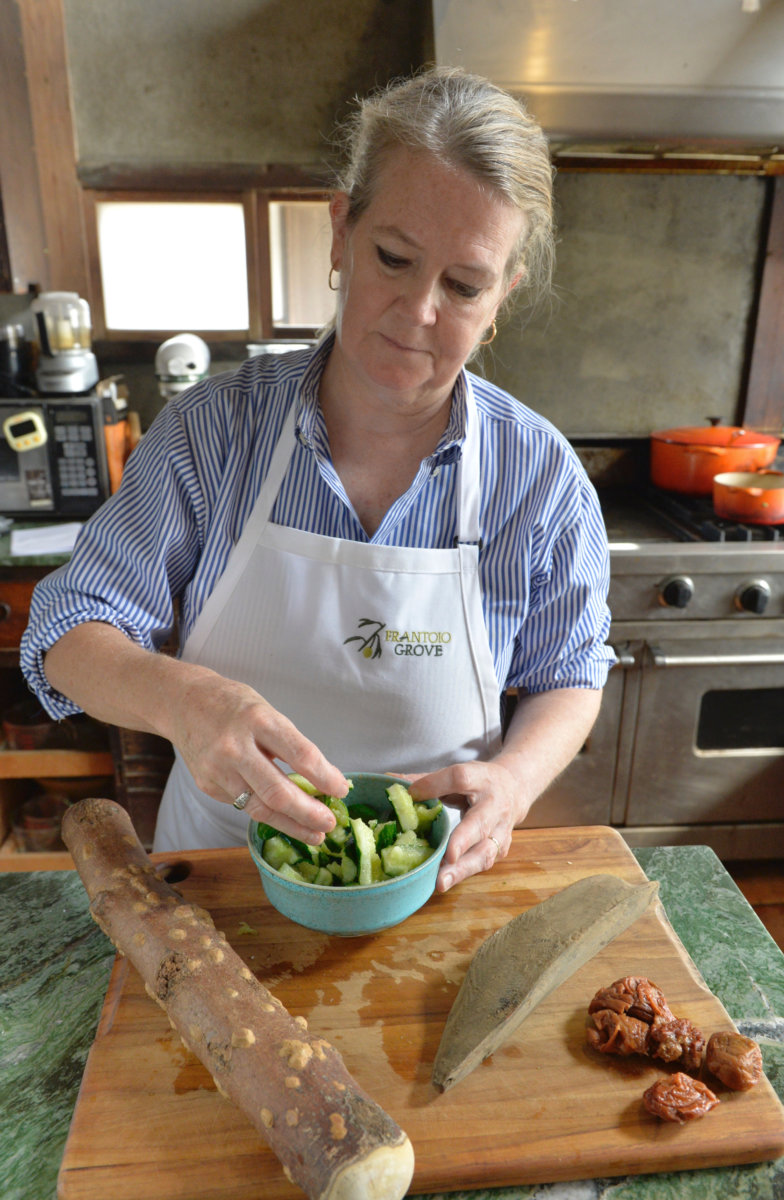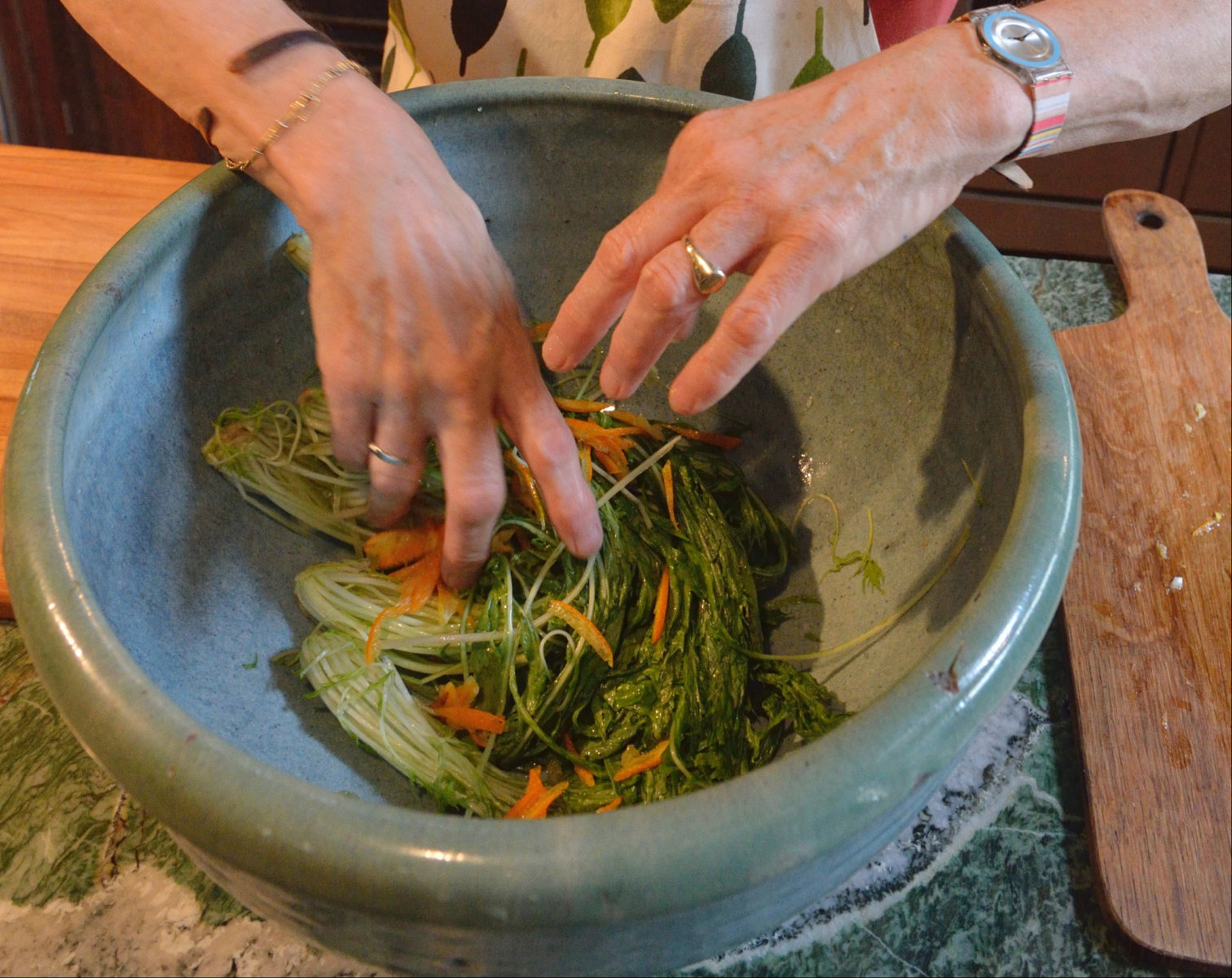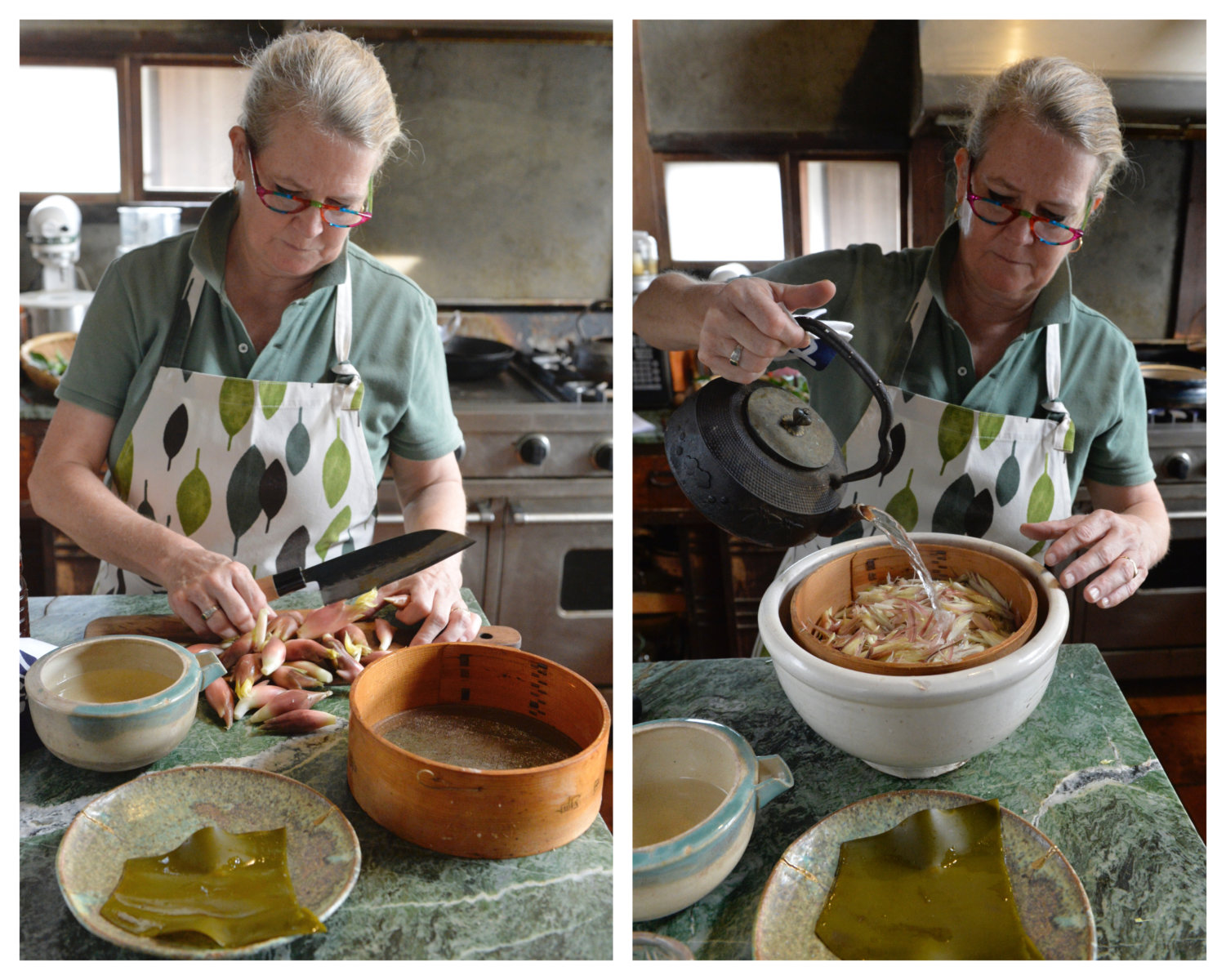James Beard Award winner, Nancy Singleton Hachisu is an expert of unique and authentic Japanese cuisine. Born and raised in California, she first went to Japan over 32-years ago where she now lives on a farm with her Japanese husband and their family.
Nancy Singleton Hachisu: The Essence of Japanese Cuisine
James Beard Award winner, Nancy Singleton Hachisu is an expert of unique and authentic Japanese cuisine. Born and raised in California, she first went to Japan over 32-years ago where she now lives on a farm with her Japanese husband and their family.
On a quest to advocate for Japan’s disappearing food traditions, Nancy has written a series of books, Japanese Farm Food (Sept 2012), Preserving the Japanese Way (Aug 2015), Japan: The Cookbook (April 2018), Food Artisans of Japan (Nov 2019), and is currently penning a book on Japanese temple food. She is a common figure in the Japanese media, where she can be seen documenting her life, and food, on the farm, as well as her visits to artisanal producers in the more remote areas of Japan.

Aiste: What attracted you to Japan in the first place?
Nancy: Japanese food had always spoken to me, although I hadn’t eaten much of it. When I was small, we sometimes ate at an upscale sukiyaki restaurant operated by Japanese in Palo Alto, California. Later, as a teenager, I was occasionally brought to a Japanese restaurant in San Francisco by different friends’ families who had lived in Japan (amazingly it was the same restaurant!). But when I ate at a Japanese sushi bar in San Francisco for the first time, I was hooked. I loved the raw component, the eating of two pieces at a time, the engaging sushi master Sachio Kojima (with whom I am still in touch!), and mostly I loved how I felt while I was seated at the bar and when I got up to leave. I felt at peace, I felt satiated, and I felt loved by the whole experience. This was in the early 1980s in San Francisco where I was working in the bar and restaurant business after Stanford. So when I decided to “get a real job,” and attend law school, I thought adding an MA in East Asian Studies and learning Japanese would make sense…because sushi was how I had kept my equilibrium during my turbulent 20s. I wanted to know what they were always shouting about. I wanted to become part of the culture of that world. By the way, this did not mean I wanted to become a sushi master. I just wanted to explore that peaceful envelopment I always felt when I sat at Sachio-san’s sushi bar.
And as it happened, I did finally gain a sense of personal quiet and balance through these now 32 years in Japan. It has been hard-fought in a way, but I have come out the other side. Perhaps that is why I get so irritated by the false Japanese food and bastardized versions common abroad which purport to be “Japanese food” but which are effectively destroying these centuries-old Japanese foodways.
Don’t get me started!
I did finally gain a sense of personal quiet and balance through these now 32 years in Japan. It has been hard-fought in a way, but I have come out the other side. Perhaps that is why I get so irritated by the false Japanese food and bastardized versions common abroad which purport to be “Japanese food” but which are effectively destroying these centuries-old Japanese foodways.
Aiste: How did you start cooking Japanese food?
Nancy: The first time I went to Japan as a cook, I was madly following cooking shows on TV. Eventually I bought a few Japanese cookbooks and I was cooking for my friends, foreigners here, doing dinner nights. But I realized there is no sense of cooking Japanese food for them because they are in Japan, so I turned around and started cooking Western food.
With my kids we travelled a lot, so I had a huge cookbook collection from different countries. Cookbooks were mainly where I learned how to cook. I took recipes for my cooking classes for Japanese, then I started writing recipes for cooking school, then I started my blog, so it took over 10 years to build all up. I developed friendships with Japanese people who taught me a lot about Japanese cuisine, attended programs that would help my brand. So I’m not a typical person who goes from blogging to books writing. I built it slowly.
At the beginning, when I came to Japan, everything tasted good, everything was delicious and tasty, so I wanted to try more and more. We visited many restaurants here, everywhere was delicious, but the fourth time I noticed a strange taste on my tongue, I realized it was MSG. So I realized it’s not as good as I thought. Sadly, MSG in Japanese restaurants was (and still is) very common, because people are used to the flavor and it is a quick (cheap) way to give food a so-called flavor boost.
I wanted to write a book about real Japan, real people, the Japan I know. Real grandpas and grandmas. They don’t care about the foreigners, they talk to you, they don’t try to impress people… They talk like there are no boundaries, they are just people.
Because of that, I started eating more of my husband’s organic vegetables with no pesticides or animal products. After 5-10 years, if vegetables didn’t taste organic, I couldn’t eat them. Suddenly I couldn’t eat “dead taste”, I could feel it in my mouth, it’s fibre but no taste, no texture. Now the chefs in Japan are doing much better on the vegetables. 20-years ago they really knew they fish, but the vegetables were not good.
Aiste: Why 20-years ago vegetables were not good and why now it’s changing?
Nancy: Back in the days, when fishermen, farmers or mountain guys were cooking food, they were cooking really bold strong flavoured food, the actual taste of the ingredient was bold. Then when the women were cooking, there was a “housewife” style of cooking, supermarket meals or mainstream recipes from the cookbooks, post-war food, when sugar was the “queen” cause during the war there was no sugar.
I wanted to write a book about real Japan, real people, the Japan I know. Real grandpas and grandmas. They don’t care about the foreigners, they talk to you, they don’t try to impress people, don’t put more sugar or wrap presents into papers. They talk like there are no boundaries, they are just people. So I just wanted to say “Hey, this is my Japan, this is the food we eat.” So some of the recipes are from my husband, some are from my friends.
Aiste: How would you describe your cooking?
Nancy: When I travelled around Japan I noticed that people are not cooking, they eat stuff from convenient stores, even grandmas do. When you look at supermarket baskets, they all buy premade food, it’s way better than in America, but still, it’s a lot. And the grandmas are so tired, for sure they are buying stuff from a supermarket. So maybe “well to do families” who are cooking at home from good ingredients. In the new families, they are so busy with work, that they are used to that food.
So for my book, I consulted with two ladies who had published very veggie-centric, healthy Japanese food books, they had very loose recipes with no measurements, the techniques were written but very bare-bone, so I specified by adding with proportions. So it’s 100% authentic in terms of method, but it’s skewed to my taste. There are so many different variations on a simple dish, which could go from farm preparation to Kaiseki. For example Goma-ae [a form of salad], it can be with spinach or broccoli, it can be used on many many different things, but also it can be prepared differently, with this or that seasoning. That really needs to be understood by people, that there is no one recipe. Understanding the heart of Japanese food is missing in Westernised Japanese food, which I have seen in recipes. You can change a bit, but don’t lose the heart of Japanese food.
When I see different kinds of meat or fish on a menu I wonder where the vegetables or tofu are, even miso is so salty, you need balance, less is more and balance.
Aiste: Why do you think the rest of the world is so fascinated by Japan?
Nancy: I suppose for the same reasons I was originally: the quiet, peaceful feeling you assume from the culture, and perhaps the design element, the dichotomy of old and modern. For food people now, it is about unusual and delicious ingredients. But again the versions of these artisanal foods found in most of Japan or abroad are not well made. I am closely aligned with artisanal makers and there is a nascent but growing movement of people championing Japanese artisanal foods and foodways, so look out!
Aiste: What are your favourite ingredients in your kitchen?
Nancy: Frantoio Grove olive oil (made by my brother-in-law in California), Wajima Kaien salt from Ishikawa, Iio Jozo premium rice vinegar, Yamaki Jozo shoyu, ponzu, and miso, and of course, the BEST sesame oil, paste, and seeds in the world from Wadaman Sesame in Osaka. And Mikawa Mirin.

Aiste: What is the heart of Japanese food?
Nancy: It’s approaching with respect and a light hand. For example, miso soup, should be made with maximum of 3 ingredients (clear dashi, miso, tofu and a bit of garnish). Everywhere is too much of everything. There is a famous saying – LESS IS MORE. Kanji Nakatani, a well-respected Soba chef, always tells you that you should season up to 80%, but you should always leave them wanting more. That way, actually they will eat more. So it’s a really important rule of Japanese food. When I see different kinds of meat or fish on a menu I wonder where the vegetables or tofu are, even miso is so salty, you need balance, less is more and balance. So that attracts you and me to Japanese food. But if I go for example to London Japanese restaurants, I look at the menu and I know that is not Japanese food. If you are eating that kind of food and thinking that this is Japanese food, you won’t understand the idea that Japanese food is about clarity, feeling that you are eating healthy food. Culturally and historically, many vegetables in Japanese cuisine have been there for very long.
Unfortunately, most of the young people grew up eating processed foods so they do not have the experience of “mom’s taste” or “grandma’s taste” that older urban Japanese talk about nostalgically.
So I wrote my book in understandable English and not changing but adjusting the recipes, simplifying the words and techniques.
My goal in writing books is to contribute to authentic Japanese cuisine. It’s not Westernised, it’s a solid authentic piece, the recipes are not mine, but I wrote them to be relevant today, for these times.
Aiste: What would be your advice for the first-time home-cooks of Japanese cuisine?
Nancy: Start simple. Find good base ingredients – your best source is online macrobiotic or organic sites. Less is more. Japanese food should not be goopily sauced or fatty or unbalanced.
Aiste: How do you see the future of Japanese cooking?
Nancy: Well, the sad story is that the government is quite worried about the state of Japanese food since fewer and fewer people are cooking. Most Japanese have no issue with eating several meals a week purchased at the convenience store. Supermarkets sell year-round vegetables, so the concept of seasons is being lost. MSG is king, no doubt. But there is a slow emergence of people caring about, talking and making the effort to source better food – local, organic perhaps. Japan is a small country so change can happen if we engage young people. Unfortunately, most of the young people grew up eating processed foods so they do not have the experience of “mom’s taste” or “grandma’s taste” that older urban Japanese talk about nostalgically. I have great hopes, however. Mostly, I am extremely worried about the world chefs borrowing Japanese traditional methods and changing them to suit their whims. Traditional foods all around the world are threatened and Japanese foodways are in a tenuous spot.
There is a lot of misinformation out there. I recently saw a YouTube video via Eater about a young shoyu maker using traditional methods to make shoyu from Japanese soybeans in cedar barrels. Of course, it was important to tell this story, but the reality is that this two-hundred-year-old shoyu maker is also making several lower grades of shoyu from non-Japanese beans, so the story was only part of the story. In fact, Japanese soybeans in general are endangered because China, US, and Canada can grow huge amounts (for oil, so not exactly the best beans for shoyu since shoyu soybeans should be high in protein not oil) cheaper than in Japan. And the sad truth is that the majority of organic Japanese shoyu purchased in bulk and rebottled by organic companies around the world is made from Chinese organic beans, which are cheaper than Japanese conventional and grown for max oil production rather than shoyu.

Aiste: If you had to choose just one dish to cook, what would that be?
Nancy: That is a hard one…I guess nabe (one-pot) – specifically shabu shabu – because there are so many variations but it has a super simple base: kombu dashi, cotton tofu, negi, napa cabbage, komatsuna, shiitake. Plus some sort of meat or fish protein, if you are so inclined, to dip into the pot as you go. A splash of ponzu in your bowl seasons the soupy vegetables and tofu and meat or fish. It is easy, delicious, fun, and you feel clean after eating it. A bowl of rice on the side or udon noodles in the soup at the end, finishes the meal.
